BriXs Ultra High Flux Inverse Compton Source Based on Modified Push-Pull Energy Recovery Linacs
Abstract
1. Introduction
2. Machine Layout
3. Injector
4. Accelerator Section
- ERL(KEK), 100 mA current target still to be demonstrated. The based accelerating unit is a cryomodule with two 9-cells cavity design to suppress HOM-BBU up to the nominal current (theoretical limit is 200 mA). It has demonstrated an up to 1 mA CW operation with a % energy recovery and providing a 15 MV/m accelerating gradient. The TESLA-geometry cavity has been modified to accommodate two HOM absorbers able to dissipate up to 150 W. These cavities are operated at 2.0 K.
- CBETA (Cornell), multi-pass ERL demonstrator, linac module tested, Design Report. Each module consists of six 7-cell cavities, designed to operate in CW mode at 16 MV/m with a HOM-BBU limit at 100 mA. Specifically designed HOM absorbers installed on both sides are able to handle up to 400 W of dissipated power. These absorbers are isolated from the cavity and they are eventually cooled with liquid nitrogen. The module has been successfully tested and has reached the designed performances. The cryogenic operation temperature for this project is 1.8 K.
5. Electron Beam Lines
- a quadrupole triplet (, , in Figure 4), located downstream the SC Linac ERL1, matches the beam to the first chicane and allows for quadrupole-scan emittance diagnostic; electron bunches travel through these elements in both directions, outgoing from the accelerator or backwards from the specular path;
- a dog-leg chicane, composed of two dipoles (, ) and three quadrupole lenses (, , in Figure 4) closing the chicane dispersion, transports the beam to the IP line;
- the IP region includes two strong focusing triplets (,, and ,, in Figure 4), symmetrically installed w.r.t. the IP, and the 1 m long Fabri-Pérot Optical Cavity. This section has identity transport matrix, so different focusing settings at IP can be adopted without affecting the magnetic elements downstream. The electron beam rms transverse dimensions from the Linac exit to the interaction point are shown in Figure 6;
- a double bend achromat () section with two dipoles ( and ) and three quadrupoles (, , ) deflects the beam by and closes the dispersion at its end;
- a long dog-leg chicane with two dipoles ( and , similar to and ) translates the beam to the second SC Linac; the , , triplets provide control the clearance of the first quads to avoid interference at the X-cross of the two beam lines;
- the triplets “1” in Figure 5 are identical and specular structures.
6. Laser System
7. High Finesse Cavity
8. Expected Performance
9. Conclusions
Author Contributions
Funding
Conflicts of Interest
References
- MARIX Conceptual Design Report. Available online: www.marix.eu (accessed on 7 September 2019).
- Serafini, L.; Bacci, A.; Bellandi, A.; Bertucci, M.; Bolognesi, M.; Bosotti, A.; Broggi, F.; Calandrino, R.; Camera, F.; Canella, F.; et al. MariX, an advanced MHz-class repetition rate X-ray source for linear regime time-resolved spectroscopy and photon scattering. Nucl. Instrum. Methods Phys. Res. 2019, 930, 167–172. [Google Scholar] [CrossRef]
- Hoffstaetter, G.; Trbojevic, D.; Mayes, C. CBETA Design Report; BNL-114549-3027-IR; Brookhaven National Laboratory: Upton, NY, USA, 2017.
- Mettivier, G.; Drebot, I.; Bacci, A.; Petrillo, V.; Rosetti, M.; Rossi, A.; Serafini, L.; Calandrino, R.; Cattaneo, M.; Fiorini, C.; et al. [OA192] Kilovoltage rotational radiotheraphy with the marix/brixs source for partial breast irradiation. Phys. Med. 2018, 52, 74. [Google Scholar] [CrossRef]
- Dunham, B.; Barley, J.; Bartnik, A.; Bazarov, I.; Cultrera, L.; Dobbins, J.; Hoffstaetter, G.; Johnson, B.; Kaplan, R.; Karkare, S.; et al. Record high-average current from a high-brightness photoinjector. Appl. Phys. Lett. 2013, 102, 034105. [Google Scholar] [CrossRef]
- Gulliford, C.; Bartnik, A.; Bazarov, I.; Dunham, B.; Cultrera, L. Demonstration of cathode emittance dominated high bunch charge beams in a DC gun-based photoinjector. Appl. Phys. Lett. 2015, 106, 094101. [Google Scholar] [CrossRef]
- Sannibale, F.; Byrd, J.; Filippetto, D.; Johnson, M.; Li, D.; Luo, T.; Mitchell, C.; Staples, J.; Virostek, S. Upgrade Options Towards Higher Fields and Beam Energies for Continuous-Wave Room-Temperature VHF RF Guns. In Proceedings of the 9th International Particle Accelerator Conference, Copenhagen, Denmark, 14–19 May 2017; JACoW: Geneva, Switzerland, 2017; pp. 542–544. [Google Scholar]
- Borland, M. Elegant: A flexible SDDS-compliant code for accelerator simulation. In Proceedings of the 6th International Computational Accelerator Physics Conference (ICAP2000), Darmstadt, Germany, 11–14 September 2000. [Google Scholar]
- Sharma, A.K.; Tsang, T.; Rao, T. Theoretical and experimental study of passive spatiotemporal shaping of picosecond laser pulses. Phys. Rev. ST Accel. Beams 2019, 12, 033501. [Google Scholar] [CrossRef]
- Schulz, S.; Grguraš, I.; Behrens, C.; Bromberger, H.; Costello, J.T.; Czwalinna, M.K.; Felber, M.; Hoffmann, M.C.; Ilchen, M.; Liu, H.Y.; et al. Femtosecond all-optical synchronization of an X-ray free-electron laser. Nat. Comm. 2015, 6, 5938. [Google Scholar] [CrossRef] [PubMed]
- Black, E.D. An introduction to Pound–Drever–Hall laser frequency stabilization. Am. J. Phys. 2001, 69, 79. [Google Scholar] [CrossRef]
- TelleG, H.R.; Steinmeyer, G.; Dunlop, A.E.; Stenger, J.; Sutter, D.H.; Keller, U. Carrier-envelope offset phase control: A novel concept for absolute optical frequency measurement and ultrashort pulse generation. Appl. Phys. B 1999, 69, 327. [Google Scholar] [CrossRef]
- Carstens, H.; Lilienfein, N.; Holzberger, S.; Jocher, C.; Eidam, T.; Limpert, J.; Tünnermann, A.; Weitenberg, J.; Yost, D.C.; Alghamdi, A. Megawatt-scale average-power ultrashort pulses in an enhancement cavity. Opt. Lett. 2014, 39, 2595. [Google Scholar] [CrossRef] [PubMed]
- Chen, P.; Horton-Smith, G.; Ohgaki, T.; Weidemann, A.W.; Yokoya, K. CAIN: Conglomerat d’ABEL et d’Interactions Non-lineaires. Nucl. Instrum. Methods Phys. Res. 1995, 355, 107–110. [Google Scholar] [CrossRef]
- Petrillo, V.; Bacci, A.; Curatolo, C.; Drebot, I.; Giribono, A.; Maroli, C.; Rossi, A.R.; Serafini, L.; Tomassini, P.; Vaccarezza, C.; et al. Polarization of x-gamma radiation produced by a Thomson and Compton inverse scattering. Phys. Rev. ST Accel. Beams 2015, 18, 110701. [Google Scholar] [CrossRef]
- Drebot, I.; Petrillo, V.; Serafini, L. Two-colour X-gamma ray inverse Compton back- scattering source. EPL 2017, 120, 14002. [Google Scholar] [CrossRef][Green Version]

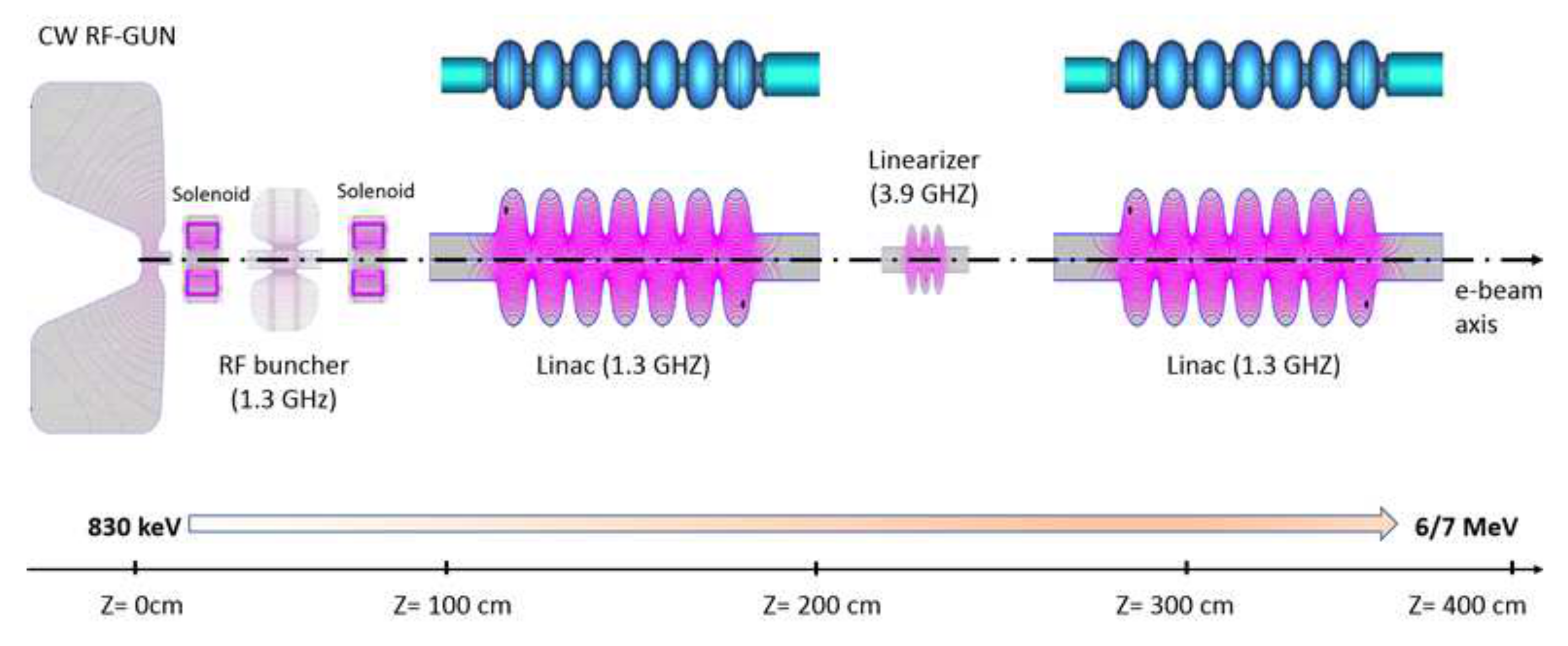

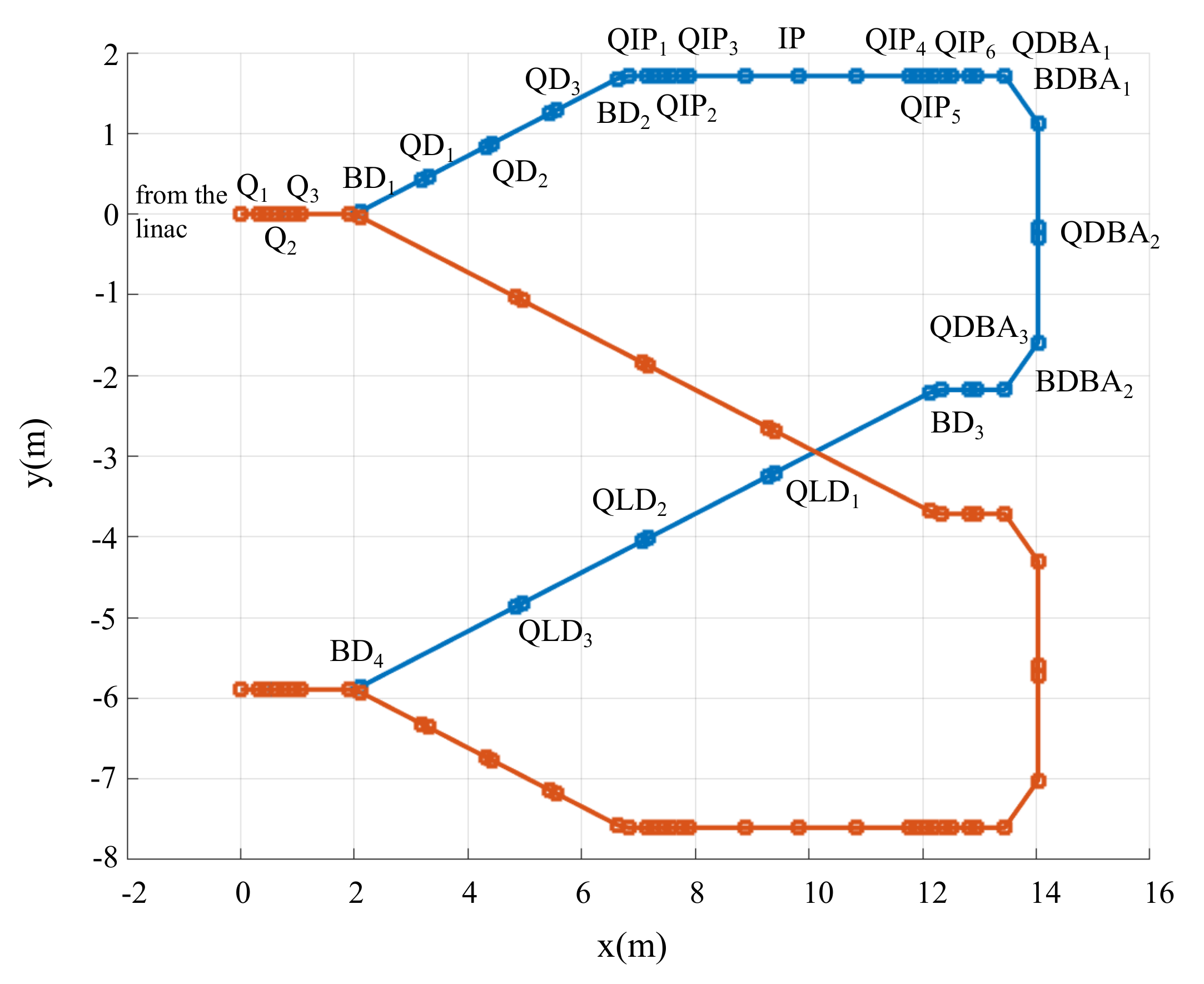



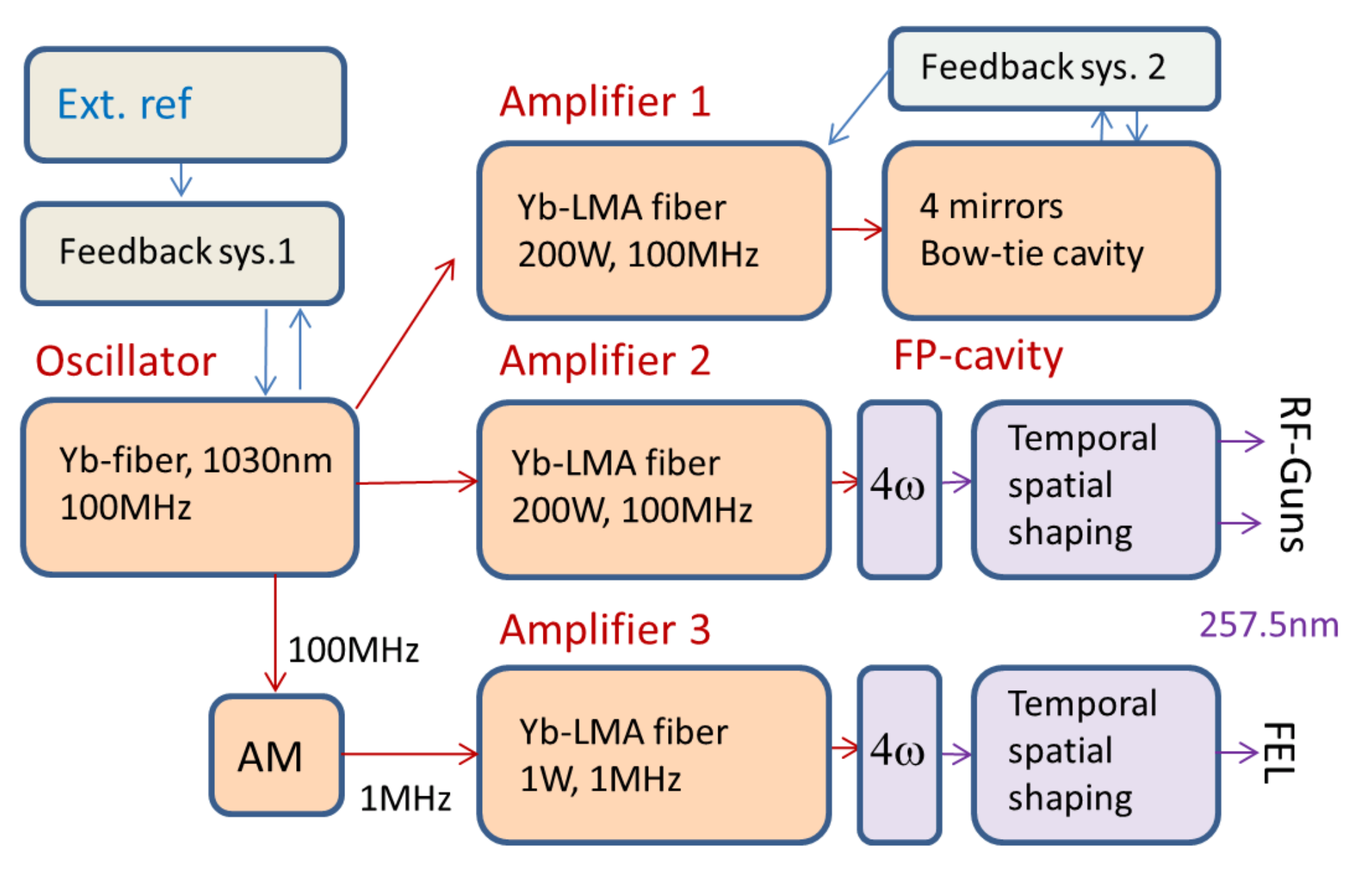
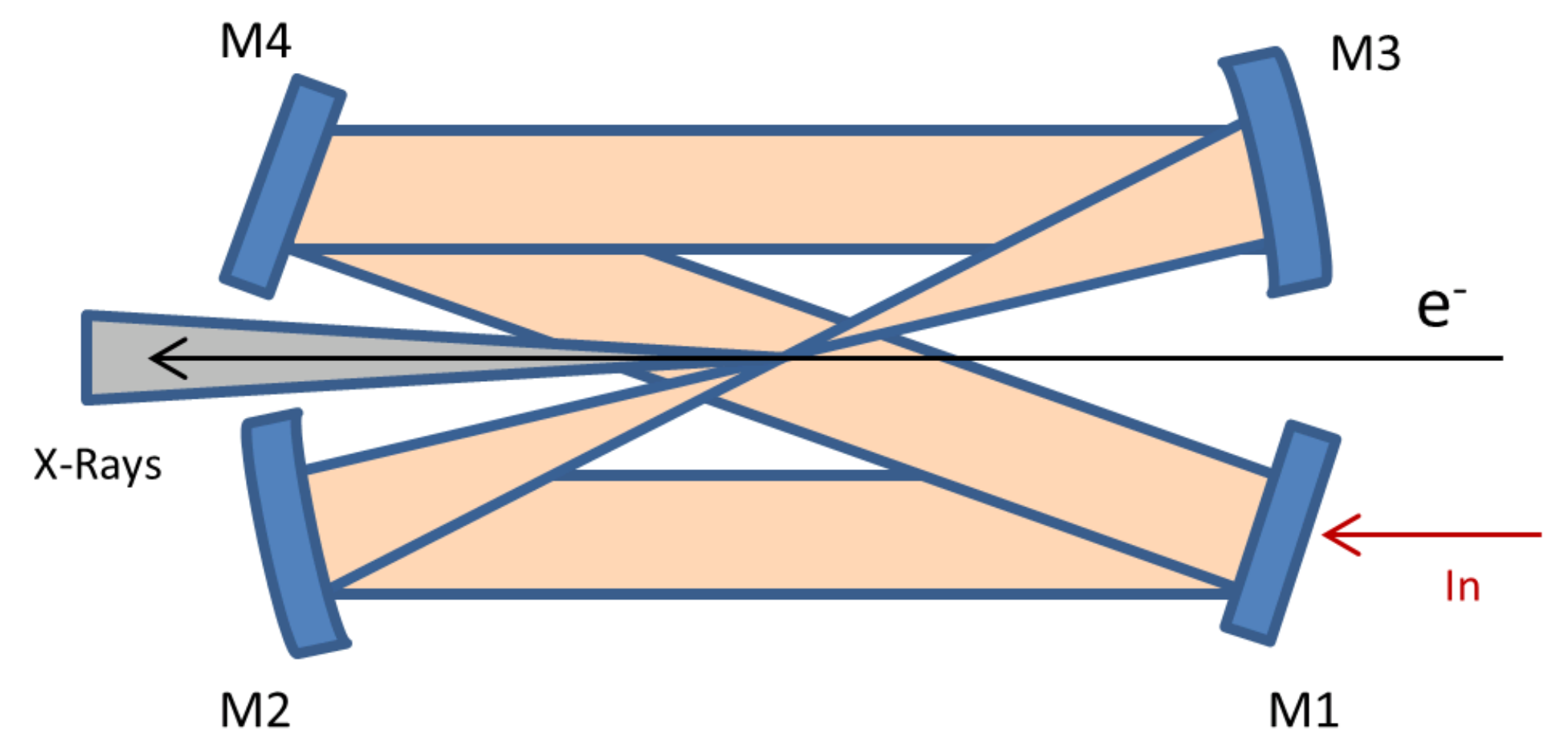


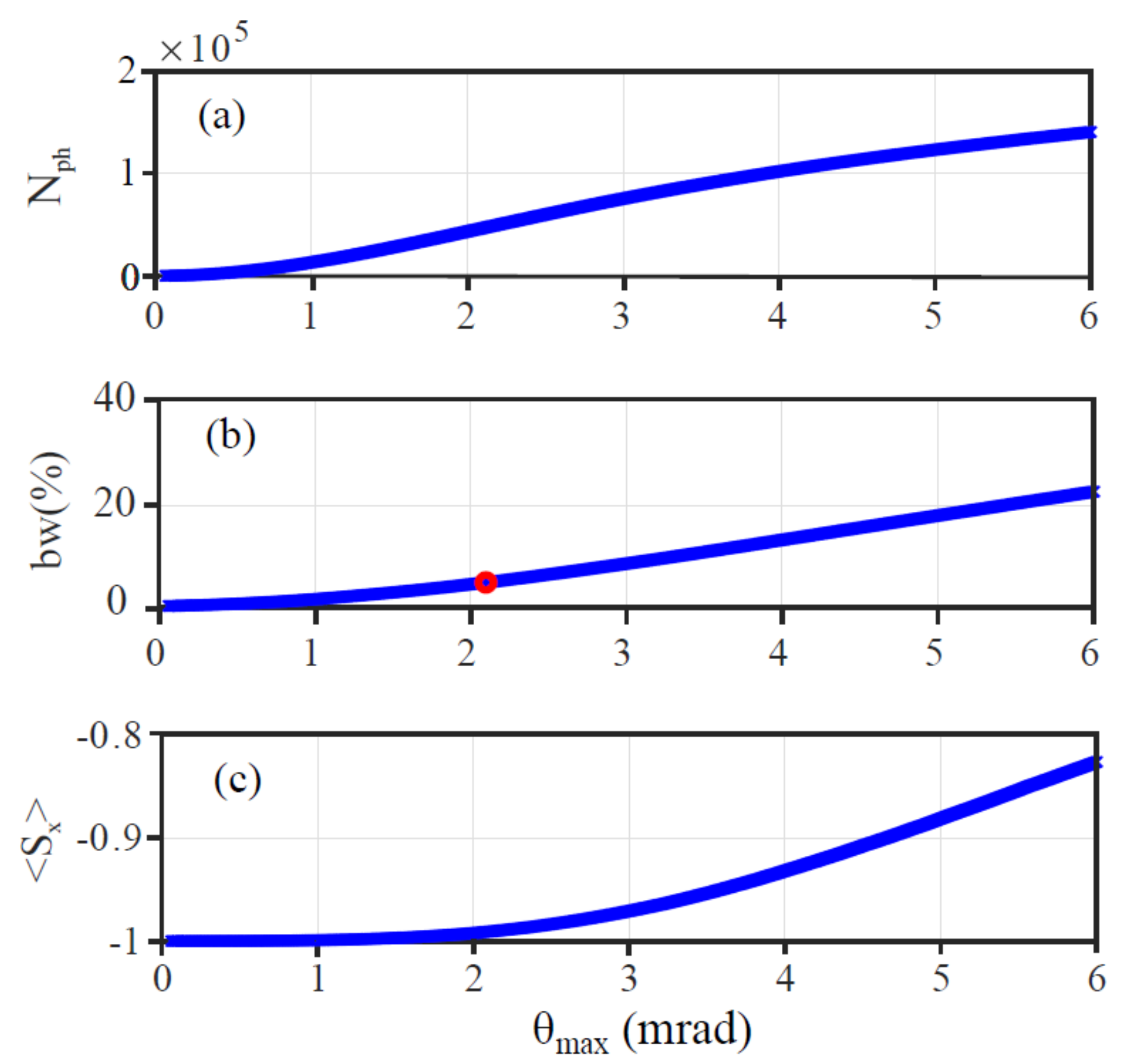

| Parameter | Value |
|---|---|
| Accelerating structure | Standing Wave |
| Accelerating mode | |
| Fundamental frequency [GHz] | 1.3 |
| Energy gain per cavity [MeV] | 12.5 |
| Accelerating gradient [MV/m] | 15.6 |
| Intrinsic quality factor | |
| Loaded quality factor | |
| Cavity half bandwidth at [Hz] | 20 |
| Operating temperature [K] | 1.8 (2.0) |
| Number of cells | 7 |
| Active length [m] | 0.810 |
| (fundamental mode) [Ohm] | 774 |
| RF power per cavity [kW] | 2.85 |
| Dynamic cryogenic losses per cavity [W] | 9.3 |
| HOM cryogenic losses per cavity [W] | 117 |
| Cavity total longitudinal loss factor for = 0.6 mm [V/pC] | 14.7 |
| Q [pC] | 200.0 |
| [MHz] | 100 |
| Average current [mA] | 20 |
| Electrons average energy [MeV] | 30–100 |
| Bunch charge [pC] | 100–200 |
| Nominal normalized , [mm mrad] | 0.6–1.5 |
| Nominal relative energy spread % | – |
| Bunch length rms [m] | 400–900 |
| Repetition rate [MHz] | 100 |
| First Triplet | IP line | DBA | |||
|---|---|---|---|---|---|
| Quadrupole | K1 (1/m) | Quadrupole | K1 (1/m) | Quadrupole | K1 (1/m) |
| 6.83 | −21.00 | −2.24 | |||
| −15.78 | 31.97 | 8.74 | |||
| 12.71 | −29.55 | −6.35 | |||
| First chicane | −10.55 | Second chicane | |||
| −9.21 | 21.88 | 6.33 | |||
| 18.68 | −10.59 | −5.35 | |||
| −10 | 6.33 | ||||
| Electrons mean energy [MeV] | 100 |
| Bunch charge [pC] | 200 |
| Nominal normalized , [mm mrad] | 1.2–1.2 |
| Nominal relative energy spread % | |
| Focal spot size , [m] % | 19.4–23.4 |
| Bunch length rms [m] | 440 |
| Laser pulse energy (mJ) | 7.5 |
| Laser pulse length [] | 2 |
| Laser focal spot size w0 RMS [] | 50 |
| Laser parameter | 0.2 |
| Collision angle [deg] | 7–10 |
| Electron Beam Parameters | |||
| Electrons mean energy (MeV) | 100 | ||
| Bunch charge (pC) | 200 | ||
| Normalized emittance , (emitt) | 1.2, 1.2 | ||
| Relative energy spread | |||
| Bunch length rms (m) | 440 | ||
| Focal spot size (m) | 19.4, 23.4 | ||
| Repetition rate (MHz) | 100 | ||
| Laser Parameters | |||
| Laser pulse energy (mJ) | 7.5 | ||
| Laser wavelength (nm) | 1030 | ||
| Laser pulse length (ps) | 2 | ||
| Laser focal spot size (m) | 40 | ||
| Laser focal spot size (m) | 80 | ||
| Collision angle (deg) | 7 | ||
| -ray Photon Beam Parameters | |||
| Relative bandwidth rms % | 1 | 5 | 10 |
| Absolute bandwidth rms (keV) | 1.98 | 8.66 | 16.01 |
| Absolute bandwidth FWHM (keV) | 3.51 | 22.7 | 47.67 |
| Collimation angle (mrad) | 0.6 | 2.08 | 3.3 |
| Peak photon energy (keV) | 183.4 | 182.4 | 180.4 |
| Mean photon energy (keV) | 181.0 | 170.4 | 158.7 |
| Photon number per shot | |||
| Photon number per shot after collimation | |||
| Source rms size , at IP (m) | 19.6, 16.7 | ||
| Source rms divergence , (rad) | 0.3, 0.3 | 1.0, 1.0 | 1.6, 1.3 |
| Source rms divergence (rad) | 0.42 | 1.41 | 2.08 |
| Spot Size at 10 m (mm) | 3.0, 3.0 | 10.5, 9.44 | 16.3, 13.0 |
| Rad. pulse length (ps) | 1.35 | ||
| Electron Beam Parameters | ||
| Electrons mean energy (MeV) | 33.5 | |
| Bunch charge (pC) | 200 | |
| Normalized emittance , (mm mrad) | 1.5, 1.5 | |
| Relative energy spread | 0.2 | |
| Bunch length rms() | 450 | |
| Focal spot size (m) | 15, 1.5 | |
| Repetition rate (MHz) | 100 | |
| Laser Parameters | ||
| Laser pulse energy (mJ) | 7.5 | |
| Laser wavelength (nm) | 1030 | |
| Laser pulse length (ps) | 2 | |
| Laser focal spot size () | 40 | |
| Laser focal spot size () | 80 | |
| Collision angle (deg) | 7 | |
| -ray Photon Beam Parameters | ||
| Relative bandwidth rms (%) | 5 | 10 |
| Absolute bandwidth rms (keV) | 0.98 | 1.81 |
| Absolute bandwidth FWHM (keV) | 2.51 | 5.78 |
| Collimation angle (rad) | 5.41 | 9.55 |
| Peak photon energy (keV) | 20.7 | 19.6 |
| Mean photon energy (keV) | 19.3 | 17.9 |
| Photon number per shot | ||
| Photon number per shot after collimation | ||
| Source rms size , at IP (m) | 19.5, 17.4 | |
| Source rms divergence , (rad) | 2.7, 2.5 | 1.9, 1.7 |
| Source rms divergence (rad) | 3.7 | 6.0 |
| Spot Size at 10 m (mm) | 27.0, 25.3 | 47.0, 38.7 |
| Rad. pulse length (ps) | 1.34 | |
© 2019 by the authors. Licensee MDPI, Basel, Switzerland. This article is an open access article distributed under the terms and conditions of the Creative Commons Attribution (CC BY) license (http://creativecommons.org/licenses/by/4.0/).
Share and Cite
Drebot, I.; Bacci, A.; Bosotti, A.; Broggi, F.; Canella, F.; Cardarelli, P.; Cialdi, S.; Faillace, L.; Galzerano, G.; Gambaccini, M.; et al. BriXs Ultra High Flux Inverse Compton Source Based on Modified Push-Pull Energy Recovery Linacs. Instruments 2019, 3, 49. https://doi.org/10.3390/instruments3030049
Drebot I, Bacci A, Bosotti A, Broggi F, Canella F, Cardarelli P, Cialdi S, Faillace L, Galzerano G, Gambaccini M, et al. BriXs Ultra High Flux Inverse Compton Source Based on Modified Push-Pull Energy Recovery Linacs. Instruments. 2019; 3(3):49. https://doi.org/10.3390/instruments3030049
Chicago/Turabian StyleDrebot, Illya, Alberto Bacci, Angelo Bosotti, Francesco Broggi, Francesco Canella, Paolo Cardarelli, Simone Cialdi, Luigi Faillace, Gianluca Galzerano, Mauro Gambaccini, and et al. 2019. "BriXs Ultra High Flux Inverse Compton Source Based on Modified Push-Pull Energy Recovery Linacs" Instruments 3, no. 3: 49. https://doi.org/10.3390/instruments3030049
APA StyleDrebot, I., Bacci, A., Bosotti, A., Broggi, F., Canella, F., Cardarelli, P., Cialdi, S., Faillace, L., Galzerano, G., Gambaccini, M., Giannotti, D., Giove, D., Mettivier, G., Michelato, P., Monaco, L., Paparella, R., Paternó, G., Petrillo, V., Prelz, F., ... Serafini, L. (2019). BriXs Ultra High Flux Inverse Compton Source Based on Modified Push-Pull Energy Recovery Linacs. Instruments, 3(3), 49. https://doi.org/10.3390/instruments3030049








